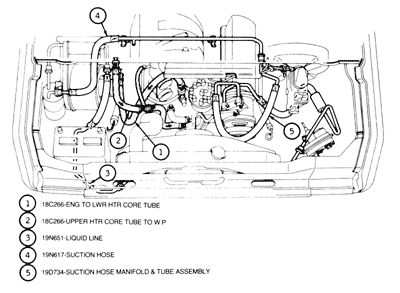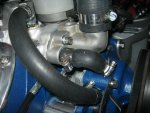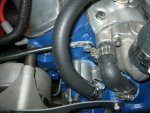Seabronc, I thought he was referring to some other type of coolant bypass that I may have been unaware of. I live in Houston, TX..so its been pretty hot and humid here. the B-Co does the same when its super hot outside (100+degrees), on hot days (90-95), and in the evening when its even cooler (80). The outside temp was about 90-95 degrees when I did the testing earlier this week. The radiator cap is not new, but it is still providing a pretty good seal when in place. what is the procedure for checking proper transmission fluid flow through the cooler??
I did some searching online and I came up with the photos below. Since my heater is not connected, can i route the bottom port of the water pump to the top of the manifold as seen in the photo? Will this help with cooling?? This port on my edlebrock perform intake is plugged as of now.
I have to apologize for my reverse labeling of the heater hoses. As far as that hookup is concerned, I would not loop the heater hose ports if the heater is cut out of the system. The reason being is that hookup will pull a lot of hot water out of the engine and just pump it, un-cooled back into the engine. It bypasses the radiator. the way you already have it is best.
OK on where you are located, on a 90 - 95 degree day, you would be amazed at the temperature of the road surface.
There is no need the measure the flow of the transmission fluid. I only wanted to make sure that the hookup allows the fluid to flow through both coolers.
Radiator caps are a pressure release device, it needs to not allow overflow into the reservoir unless the coolant system pressure exceeds the cap design. The system needs to have pressure for normal running to in order to prevent the bubbles developing in the system which would reduce the efficiency of the system, (watch a pan of water as it heats up and starts releasing oxygen as it gets up close to 200 degrees). Keeping the pressure high in the system prevents the release of oxygen bubbles. Developing bubbles in the system reduces the heat transfer. Only liquid contact to the metal will help cool the engine.
Just to be on the safe side, you can have your system pressure tested or just buy a new cap.
Also, since you live in a normally hot area of the US, I would not use a 50/50 mix, adjust up in the Winter if necessary. The 50/50 mix is for areas that normally regularly get down to the 0 degree area. Without looking, I believe 50/50 is good for about -20 degrees. Real frigid areas would need a higher ratio of antifreeze in the Winter.
So, my suggestions are:
1. New cap
2. Adjust ratio of antifreeze to water so that it still has protection for your area based on the chart on the antifreeze bottle. The more water the better the efficiency of the liquid to cool.
3. If necessary, I already told you what I did as far as the radiator and fan are concerned. That, along with adding an external tranny cooler to my system made my system bullet proof for the "Dog Days" of Summer.
All of my modifications came from suggestions in, "Ford Muscle Magazine", and they worked far beyond what I expected.
Those are all the recommendations I can give you based on my experience. I actually had a proposed change to the pump, but never went that far as it was not necessary.
That's all folks!

>-
PS. From a picture you posted, if you want a heater, it appears that yo have a bit more work to do than just re-plumbing the coil.



